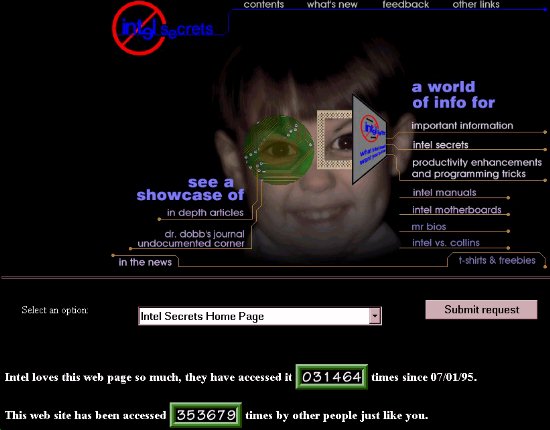
The often critical content of Robert Collins' World
Wide Web site, above, isn't the problem says Intel. It's the altered logo,
right, which the company says is artwork it has a right to protect.
|
On-line spoof has 'tarnished' logo, claims unamused chipmaker
Published July 26, 1996
Associated Press
BY CATALINA ORTIZ
Associated Press Staff Writer
Collins thought Intel Corp. might be miffed by
his Web site that reveals undisclosed details of the company's computer
chips. And was right - but not for the reason he expected.

|
Intel wants Collins to stop using a spoof of its
company logo on his site. The world's largest chipmaker argues that Collins
has "tarnished" its logo, a valuable property it says it must
protect.
But Collins, a Texas computer Chip design engineer,
says his takeoff is legitimate.
"It's a parody," he said Thursday. There
also is a disclaimer and marked differences between the logos, which he
said ensure that viewers understand he has no connection with Intel.
Collins has maintained his site, "Intel Secrets:
What Intel Doesn't Want You to Know," on the Internet's World Wide
Web for the past year. The site - http:://www.x86.org
- offers information on errors in Intel's industry-leading chips and gives
programming tips.
The content of the Web site - information that
can be obtained legitimately from working with the chips - isn't the issue,
Intel said. It's what Collins did with Intel's logo, a distinctive arrangement
of letters in the company's name.
"Our view is he's tarnished that logo,"
said Chuck Mulloy, a spokesman for Santa Clara-based Intel.
The company's logo is the word "intel"
in lower-case with the "e" dipped below the other letters. Collins'
"intel seerets" logo uses the same typeface as Intel but reverses
the letter "e" and puts over the word the international symbol
of a red circle with a line across it. It also puts the word "secrets"
in the same typeface and dips the first "e."
Collins' argument that his logo is just a parody
- a fair use of the symbol - doesn't work, Mulloy said. While people can
properly parody company's name, he said, they cannot properly parody a
logo, which is considered artwork.
"The issue here is it's just like any other
piece of property. And it's our obligation to protect Intel property,"
Mulloy said. "And if we don't take active steps to protect it, we
could lose our legal rights."
Intel, which has its own site at http://www.intel.com,
does not intend to go after Collins for alleged trademark violation, he
said. But it does intend to fight his application to trademark his "Intel
Secrets" logo.
Collins, who works for Texas Instruments Inc,
in Dallas, points out he already has changed his logo at Intel's request.
But Intel said the changes don't go far enough.
Originally Collins just used his version of the
words "intel secrets." He later added the red circle, the disclaimer
and "Intel Absolutely Not Inside," a jab at the company's "Intel
Inside" phrase.
Collins is not optimistic that he'll be able to
fend off Intel's legal opposition to his trademark application. He does
think, however, that he and the company eventually will reach some kind
of agreement.
But the company might regret it because he'd relish
putting "a lot more satire" about Intel on his Web site, he warned.
Back to In The News


© 1996 Associated Press. This article was reprinted with
permission. PGP key available.
Make no mistake!
The Intel Secrets web site is proud to provide superior information
and service without any affiliation to Intel.
"Intel Secrets" and "What
Intel doesn't want you to know" are phrases that infuriate
Intel Corporation.
Pentium and Intel are trademarks of Intel Corporation. 386, 486, 586, P6,
and all other numbers…are not!
All other trademarks are those of their respective companies.
See Trademarks and Disclaimers for more
info.
Robert Collins is a Senior Design Engineer and Manager of some sort of
Research in Dallas, TX. Robert may be reached via email at webmaster@x86.org
or via phone at (214) 797-6072.


